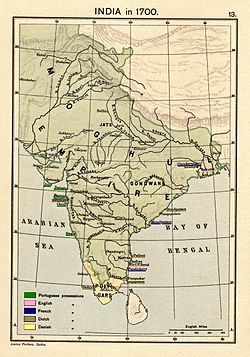| Revision as of 16:49, 26 December 2024 editJohnbod (talk | contribs)Autopatrolled, Extended confirmed users, IP block exemptions, Rollbackers280,708 edits add← Previous edit | Revision as of 22:42, 26 December 2024 edit undoJohnbod (talk | contribs)Autopatrolled, Extended confirmed users, IP block exemptions, Rollbackers280,708 edits →See also: addNext edit → | ||
| Line 29: | Line 29: | ||
| ==See also== | ==See also== | ||
| *] | |||
| *] | *] | ||
| *] | *] | ||
Revision as of 22:42, 26 December 2024
Not to be confused with Emperor of India.

Emperor of Hindustan sometimes also translated as Emperor of India was an imperial title used by the Delhi Sultanate and the Mughal Empire to signify their sovereignity over Northern India and later the Indian subcontinent.

The term was simultaneously used for Northern India and the Indian subcontinent during the Medieval period. During the rule of the Mughal Empire in the 16th century, the term was equivalent to Emperor of India.
Even after Mughal rule had collapsed, by about 1720, the other powers in India, such as the Maratha Confederacy, the British East India Company and many others, continued to use the title in certain contexts until the Mughal Empire was formally abolished in 1858. For example, the East India Company issued coinage in the name of the "emperor", and bearing this title, until then. Part of the reason for this was to avoid other powers claiming the title, during the prolonged struggle for supremacy in India.
History
Delhi Sultanate
After the Delhi Sultanate gained independence from the Ghurid Empire, it called its land Hindustan, representing its sovereignity over Northern India (Punjab and the Indo-Gangetic plains) and later the Indian subcontinent.

Scholar Bratindra Nath Mukherjee states that during the Delhi Sultanate, Hindustan simultaneously represented Northern India as well as the entire Indian subcontinent.
Mughal Empire
The Delhi Sultanate was succeeded by the Mughal Empire, which called its polity Hindustan. By this period, Hindustan had come to mean the entirety of the Indian subcontinent rather than only Northern India.

Variations
The title Emperor of India was also used for the Mughal emperors in some translated sources, a term later used by British monarchs.
Other variations were also used:
Sultan of Al-Hind (Salṭan-i-al-Hindīyyah)
Sultanate of Hindustan (Salṭan-i-Hindūstan)
See also
- Hindustan
- List of sultans of Delhi
- List of emperors of the Mughal Empire
- Monarchs of India
- Emperor of India
References and notes
- Only during the period of the Mughal Empire during and after the 16th century.
- Larned, Josephus Nelson (1895). History for Ready Reference: From the Best Historians, Biographers, and Specialists; Their Own Words in a Complete System of History ... C.A. Nichols Company.
- Hindustan), Jahangir (Emperor of (1999). The Jahangirnama: Memoirs of Jahangir, Emperor of India. Freer Gallery of Art, Arthur M. Sackler Gallery. ISBN 978-0-19-512718-8.
- Journal of Historical Research. Department of History, Ranchi University. 1983.
- Jackson, Peter (16 October 2003). The Delhi Sultanate: A Political and Military History. Cambridge University Press. p. 86. ISBN 978-0-521-54329-3.
- Mukherjee, Bratindra Nath (1989). The Foreign Names of the Indian Subcontinent. Place Names Society of India.
- Vanina, Evgenii͡a I͡Urʹevna (2012). Medieval Indian Mindscapes: Space, Time, Society, Man. Primus Books. ISBN 978-93-80607-19-1.